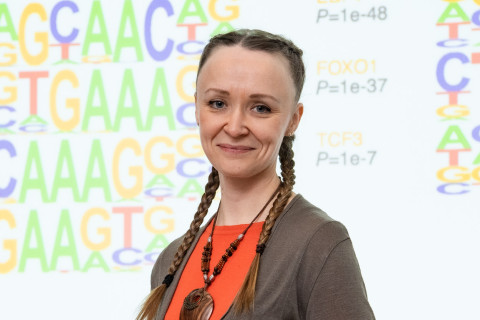Childhood leukaemia subtypes are increasingly better known
Researchers can now investigate individual leukaemia cells to find out what makes them resistant to treatment. “Single-cell technologies provide an immense amount of new information on the diversity of cancer cells,” says Merja Heinäniemi, Professor of Computational Biomedicine.
To keep it short and simple, computational biomedicine focuses on the analysis, interpretation and combination of diverse data that with current technologies can be measured in huge amounts from humans and animal and cell models. Their joint analysis requires versatile computational methods. New genomics methods can, for example, be used to investigate genetic defects underlying diseases as well as the activity of gene transcription throughout the genome. In addition, analyses can be carried out on a cell-by-cell basis, allowing researchers to accumulate data from, for example, tens of thousands of individual cells.
“In our research projects, we focus on what perspectives the data collected open up to the disease being studied. Biomedical measurements generate numerical data to which different methods of data science, bioinformatics or, for example, physics can be applied, depending on the underlying questions.”
As a good example of the possibilities of data-driven research, Heinäniemi mentions a collaborative study together with researchers at the University of Helsinki and the University of Tampere that produced a large-scale survey of the immune landscape of blood cancers in a dataset of 10,000 patients.
“By using innovative analytics methods, we were able to combine the molecular features of blood cancers with the activity of different immune cells. This brought a new perspective to the assessment of blood cancer prognosis and revealed subtypes of blood cancer that could benefit from immunotherapy.”
Striving for targeted therapies
One of the key research themes of the Systems Genomics group led by Heinäniemi is pediatric acute leukaemia, and the current focus is particularly on early treatment response.
“We know that the patient’s prognosis is largely dependent on the effectiveness of the currently available drugs during the first month of treatment. We study what happens in the cells of patients with a slow initial response to treatment and a higher risk of recurrence. The idea is to find early identifiable features that would enable these patients to receive treatment that is better suited to them.”
“In the past, the characteristics associated with recurrence have been studied mainly in patients who have already had a recurrence of the disease. Studying the early response to treatment may therefore open up new perspectives.”
“By sequencing at single cell resolution, we can examine a large number of cells individually and see what makes them resistant to treatment. This provides a better understanding of the diversity of cancer cells and can lead to the detection of rare cell types that are characteristic of the disease but haven’t been found before.”
More detailed information on the subtypes of leukaemia helps to develop increasingly targeted treatments. This will also help patients who are currently difficult to treat, while others can avoid unnecessary heavy treatments.
According to Heinäniemi, close dialogue between researchers and physicians in national and international networks is important for the introduction of research results into drug trials and, ultimately, into care guidelines.
“The sequencing of patient samples is also becoming more common in hospitals, and the threshold for using genomics in the treatment of patients may become lower as we provide research-based insight into the interpretation of the data.”
Heinäniemi is originally trained as a biochemist, but she did a career transition from laboratory work to computational analysis. As the leader of a multidisciplinary research group, she wants to avoid becoming fixed in ways of thinking.
“In many cases, the best solutions are found when ideas are tossed around between people with different skill sets. In a dialogue-friendly atmosphere, it’s easy to ask even stupid questions and to strive for a common understanding.”
Education in computational biomedicine is strengthened – new data analysis services for researchers
Interdisciplinary teamwork and crossing the language barrier between different disciplines is something Heinäniemi wants to emphasise also in biomedicine education. As of next autumn, computational biomedicine will become a new specialisation alternative in the University of Eastern Finland’s biomedicine programme.
“Already now, studies in biomedicine provide a basic understanding of data-based methods, but in the new specialisation, students will focus even more on how data science and mathematical modelling is applied to biomedical research. Here we are combining the university’s offering in data science and the research groups’ expertise at the Institute of Biomedicine.”
As another new opening, especially for researchers, Heinäniemi points out that the services of the Bioinformatics Centre will be expanded. Located on the Kuopio Campus, the Bioinformatics Centre maintains a server infrastructure suitable for the management of extensive research materials and for heavy scientific computing, and it provides expert services and training. Since last summer, researchers have also been able to purchase data analysis services.
“The need for data analysis services has been acknowledged at the university, but these services can also be used by researchers other than the university’s own. It is also hoped that the services can be scaled to demand.
Merja Heinäniemi
- Professor of Computational Biomedicine, University of Eastern Finland, 1 March 2021–
- Title of Docent in Bioinformatics, University of Turku, 2014
- PhD (Biochemistry), University of Kuopio, 2007
- MSc (Biochemistry), University of Kuopio, 2005
Key roles
- Associate Professor (Tenure track), University of Eastern Finland, 2014–2020
- University Lecturer and UEF Postdoctoral Researcher, University of Eastern Finland, 2012–2013
- Postdoctoral Researcher, University of Luxembourg, 2007–2012
- Visiting Researcher, Institute for Systems Biology (ISB), USA, periods in 2009, 2011 and 2017
